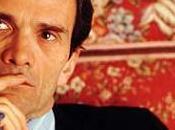In primo luogo abbiamo chiesto a Francesca in quale modo la satira così come veniva fatta in modo tradizionale sui giornali tradizionali si possa conciliare con i nuovi strumenti, ovvero social media e i giornali online. A suo avviso i social media rappresentano un volano formidabile per la satira, specialmente perché ci sono sempre meno editori disponibili a investire per la diffusione delle notizie, e ancor meno per la satira. La satira in fondo è una presa in giro del potere, che quindi è restio ad alimentare i giornali satirici. Internet, d’altro canto, è gratuito: è possibile scrivere, disegnare e infine diffondere i propri contenuti online gratuitamente, senza alcun costo di distribuzione. [video]
Per quanto riguarda invece le integrazioni tra strumenti, nel rapporto tra online e offline, secondo Francesca nel futuro ci sarà sempre più un unico elettrodomestico, che sarà giornale, tv, internet, offrendo contenuti sempre più un demand, e non secondo un palinsesto imposto dall’alto, cosa che varrà sia per la satira che per la cronaca che per l’entertainment.
Si tratta di una grande opportunità specialmente per gli esordienti: la diffusione della tecnologia permette a tutti di mettersi in gioco, girare un video e creare dei contenuti. Secondo l’articolo 3 della Costituzione Italiana spetterebbe allo Stato togliere gli ostacoli all’uguaglianza tra cittadini: secondo Francesca, in questo caso, dove non arriva lo Stato arriva la tecnologia. [video]
 Spesso gli editori considerano le attività online come una minaccia per le vendite, aspetto che Francesca analizza da due diversi punti di vista: quello del giornalista satirico che fa i contenuti, per cui le nuove tecnologie rappresentano un’opportunità; dall’altra parte quello dell’editore.
Spesso gli editori considerano le attività online come una minaccia per le vendite, aspetto che Francesca analizza da due diversi punti di vista: quello del giornalista satirico che fa i contenuti, per cui le nuove tecnologie rappresentano un’opportunità; dall’altra parte quello dell’editore.Si tratta però di una fase di transizione, data anche la natura dei guadagni, strettamente legati alla vendita di spazi pubblicitari. Sui giornali cartacei sono sempre di meno, a fronte di una presenza massiccia nella tv tradizionale e un trend in costante aumento su Internet, dove però vengono venduti ancora a molto poco. La quantità di persone che fruiscono di notizie, satira e arte, e il tempo che vi dedicano è sempre maggiore, il che costituisce senza dubbio un segnale positivo: non è morto il giornalismo, ma molto probabilmente sono morti i giornali di carta. [video]
Abbiamo chiesto a Francesca qual è la sua dieta mediatica: attualmente sta usando Pulp, l’aggregatore di notizie per iPad, che permette di raccogliere i feed rss dei giornali e blog preferiti. Tra le sue letture quotidiane ci sono Brancaccio, Loretta Napoleoni, Odifreddi e ZeroCalcare, giusto per fare solo alcuni esempi. Non si tratta nemmeno più di un giornale, ma di un luogo multimediale che raccoglie testi, video, fotografie e audio.
Se da un lato la preoccupazione è che questo tipo di approccio porti alla chiusura su contenuti che sono sempre gli stessi, dall’altra parte è vero che basta aprire una finestra di Twitter o Facebook per avere a disposizione stimoli sempre nuovi. Se una grande lettrice di giornali quale era Francesca, ora si ritrova a non toccare più i giornali cartacei, la transizione è presumibilmente ineluttabile. [video]
Il destino dei giornali, dunque, è di scomparire, mentre quello dell’arte e delle notizie è di moltiplicarsi, crescere ed arrivare sempre di più a tutti.
Buona visione!
Maria Petrescu
Intervistato.com | Francesca Fornario #ijf12
The third interview for the Intervistato Journalism Festival series is with Francesca Fornario, journalist and satirical cartoonist who writes for L'Unità, works for RadioDue (she conducts the program Un giorno da pecora together with Claudio Sabelli Fioretti and Giorio Laura) and for La7. Furthermore, she gathers her videos on the website www.satira.tv.
First of all we asked Francesca in what way satire, as it was done on traditional newspapers, can be reconciled with the new tools, such as social media and online newspapers. Her opinion is that social media represent an incredible opportunity for satire, especially because there are fewer and fewer editors that are willing to invest to spread news, let alone satire. Satire is making fun of power, which isn't quite willing to help satirical newspapers grow. Internet, on the other hand, is for free: you can write, draw and then spread your content online for free, without any distribution cost. [video]
As for the integration of tools, in the offline-online relationship, Francesca thinks that in the future there will only be one tool, that will be a newspaper, tv, internet, offering on demand content, not imposing it, and this will happen for news, satire, and entertainment at the same time.
This is a great opportunity for those who are just starting: the diffusion of tecnology allows everyone to record a video and create content. The 3rd article of the Italian Constitution says that the State should be the one who eliminates the obstacles in the way of citizens being equal: in Francesca's opinion, and in this case, where the State failed, technology can give a hand. [video]
Often editors consider online activities as a threat for sales, an aspect that Francesca analyzes from two different points of view: the one of the satirical journalist who creates contets, for which new technologies represent an opportunity; on the other side the one of the editor. This is a transition phase, though, also considering the gains, that only come from the sale of advertising spaces. On paper newspapers they're fewer and fewer, most of it is on TV and it's constantly growing online, even though they're sold very cheap. The quantity of people who are consuming news, satire and art, and the amount of time they dedicate to these activities is constantly increasing, which is without a doubt a positive signal: journalism isn't dead, but it's very probable that paper newspapers are dead. [video]
We asked Francesca about her media diet: she is currently using Pulp, a news aggregator for iPad, that allows you to read rss feeds of newspapers and blogs. Among her daily reads you can find Brancaccio, Loretta Napoleoni, Odifreddi and ZeroCalcare, just to name a few. It's not even a newspaper anymore, it's a multimedia place that gathers text, photos and videos.
If on the one side it might be worrying that this kind of approach might bring you to not search anything else besides what you're already reading, on the other only by opening a Twitter or Facebook page can bring you all the inspiration you need. If a great newspaper reader as Francesca was now doesn't touch paper newspapers anymore, it means that the transition is probably inevitable. [video]
The destiny of newspapers is to disappear, while that of art and news is to multiply, grow and reach more and more people every day.
Enjoy!
Maria Petrescu




